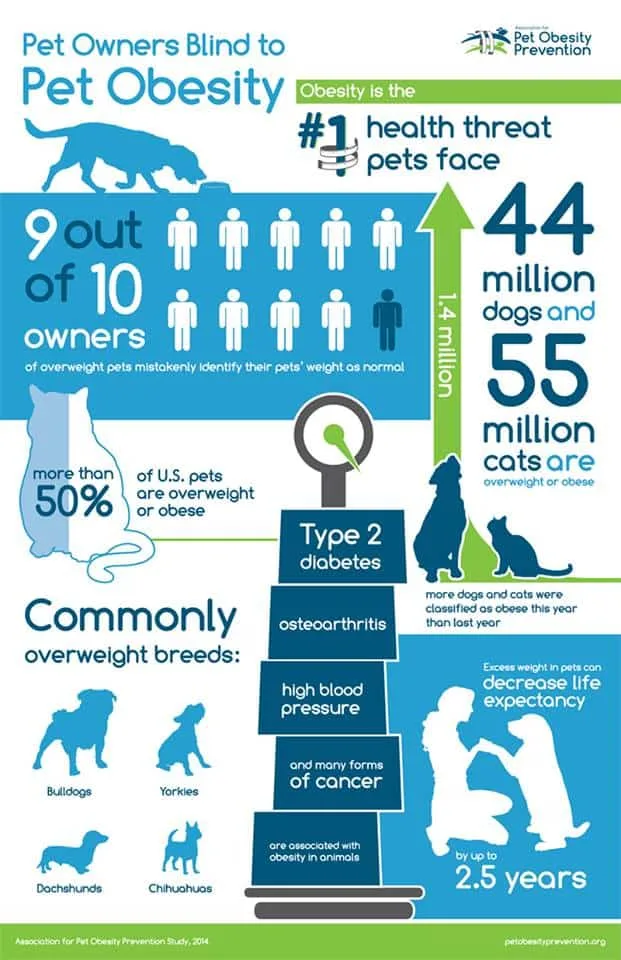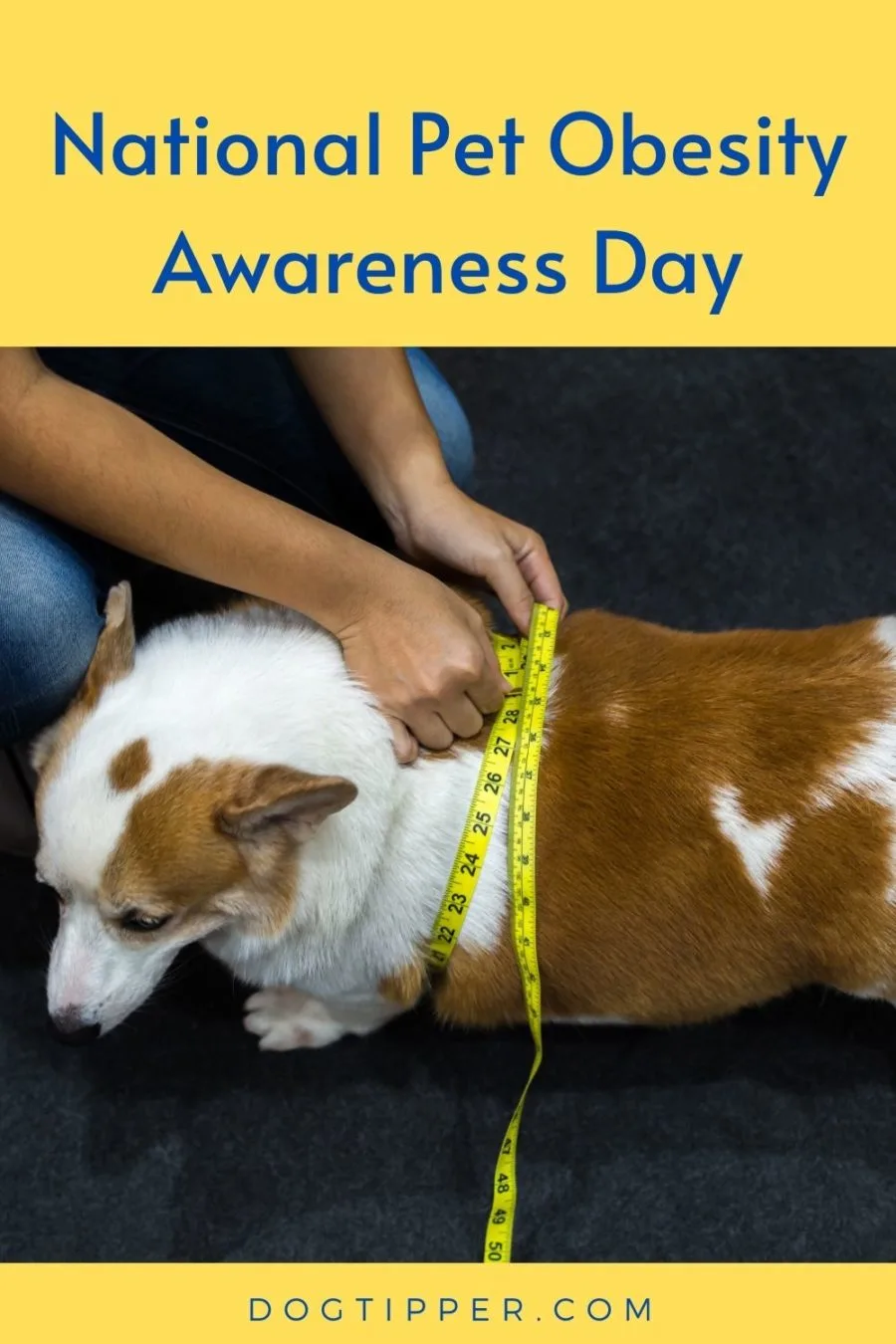As diligent pet parents, the health of our dogs can weigh heavily on our minds. If you’ve noticed that your pal with paws has started to sport a fuller frame, National Pet Obesity Awareness Day is designed to ‘get the skinny’ on ways to help your furry friend go from flab to fit.

When is National Pet Obesity Awareness Day?
In 2023, National Pet Obesity Awareness Day is scheduled for October 11. It is always observed on the second Wednesday in October.
The pet holiday was first observed in 2007, founded by the Association for Pet Obesity Prevention (APOP). On that day, hundreds of veterinarians will gather data on the waistlines of the country’s pets. Pet families can log onto the website to report their pet’s size and weight.
Why was this holiday launched?
“Pudgy pooches and fat cats are now the norm,” states Dr. Ernie Ward, founder and President of the Association for Pet Obesity Prevention (APOP). “This is the first generation of pets that will not live as long as their parents. Even worse, the majority of today’s overweight pets will endure painful and expensive medical conditions – all of which can be avoided.”
What’s the answer? Just like people, pets should eat less and exercise more.
According to Ward (who is also a certified personal trainer, USA Triathlon-accredited coach and Ironman athlete), “Your best workout buddy is your dog. They never give excuses; any chance to get outside is a good one for a dog.
“Dogs and people are a perfect match in terms of aerobic abilities, dietary needs and emotions. If you’re having a bad day, take your dog for a walk or jog. I may feel lousy at the beginning of a run with my dog, but I’ve never ended a run that way.”
How Many Dogs Are Overweight?
According to a 2014 National Pet Obesity Day survey, a whopping 52.7 percent of dogs in the United States are considered overweight or obese, and 57.9 percent of our purring pals have packed on too many pounds.

Which State Has the Most Overweight Dogs?
As pet parents the health of our tail-wagging chums can literally be a weighty issue when we notice that our pup is beginning to pack on pounds.
According to Banfield Pet Hospital’s State of Pet Health Report, the rate of overweight and obese pets has reached epidemic proportions in the United States, with one out of every four dogs and cats combating the problem.
The study also dug up the information that overweight pets have increased 37 percent in dogs and 90 percent in cats in the past five years. Minnesota, Utah, Nebraska, Nevada and Iowa are the top five states with overweight dogs.
Your Pet Obesity Resource
To help tip the scales in your pet’s favor, The Association for Pet Obesity Prevention‘s website provides dog devotees and friends of felines with an arsenal of knowledge to help your pet wage a battle of the bulge, including:
- the daily caloric needs for indoor dogs and cats.
- a downloadable daily feeding and exercise log.
- how to determine if your pet is overweight (Are their ribs difficult to detect beneath their fat? Is Mitten’s or Spot’s stomach sagging? Is your purring pal or barking buddy’s back broad and flat?)
- the calorie count of those tasty treats.
- a weight loss program chart.
- a list of the health risks (such as type 2 diabetes, osteoarthritis and high blood pressure) associated with weight gain in dogs and cats
- creative exercise ideas to encourage weight loss, such as moving your pet’s food goal to different parts of the house to promote walking.
And this certainly isn’t a problem limited to US dogs.
Considering that 1 in 14 dogs in the UK are considered overweight or obese, it is important to know the facts about how obesity can affect our pets and to understand what to do to prevent it.
Being overweight can have lasting consequences for your pet and can even be fatal. The folks at tails.com have shared their top tips to help you help your dog trim down the healthy way and maintain an appropriate weight on this pet holiday–and throughout the year:
How to reduce your dog’s weight the healthy way
As a nation of dog lovers, we can’t help but indulge our pups. But with pet obesity on the rise, a little morsel here and there soon adds up. And if we’re not careful, all those sneaky treats can lead to a podgy pooch.
While many owners use food as a way to shower their dogs with love, it could be doing more harm than good, because overweight dogs are more prone to illnesses and don’t live as long as dogs at an ideal weight. So if you think it’s time your porky pup lost a few pounds, read on for our top tips on dog weight loss the healthy way.
How to tell if a dog is overweight?
All breeds have standard weight guidelines. And while this is a good place to start, every individual dog is different. Rather than the numbers on the scale, what you should really pay attention to is the amount of extra coverage on your dog’s body. To understand if your dog is under, ideal or overweight, vets often use the body condition score (BCS) test.
The test is measured either on a 9 point or 5 point scale, and assesses your dog’s fat levels across your dog’s ribs, tummy and waist. Your dog should have an hourglass figure when viewed overhead and even breeds like bulldogs where many people believe they will be more rounded should have a waist.
You should be able to feel the ribs through a little fat covering and they may even be slightly visible in places. And the tummy should tuck up from the rib cage, rather than being a straight line across.
If your pooch is more barrel shaped and you can’t feel their ribs easily without applying a lot of pressure, then your dog is likely overweight. If you’re unsure, your vet or vet nurse will be able to help you and even show you exactly what to look for when it comes to your dog.
Health implications for overweight dogs
Not only does the lifespan of an overweight dog decrease, but it can seriously impact your pup’s quality of life.
The extra weight can put added pressure on bones and joints, potentially leading to arthritis in later years.
But it can also put your dog’s life at risk, contributing to breathing difficulties, heart problems and diabetes.
Top tips to reduce your dog’s weight
There are 3 key areas to consider when managing your dog’s weight loss in a healthy way.
Dog diet food
Feeding the right diet for your individual dog is the first important step. Balanced meals packed with nutrients, slow release carbohydrates and beneficial fibre will help your dog feel fuller for longer. It’s also important to control portion sizes and feed the exact amount your dog needs to lose weight steadily, and eventually maintain a healthy weight.
Regular exercise
Exercising your dog every day will help burn off excess calories and keep their body healthy. Alongside the right nutrition and portion sizes, a regular exercise routine will help bring your dog’s weight down steadily and predictably. It also gives your dog something else to focus on during the day, by providing mental stimulation – dogs are a bit like humans, they get peckish when they’re bored!
Limiting treats
We know it’s difficult, but cutting out treats altogether is the best approach for healthy dog weight loss. Or at the very least, limit the number of treats and offer healthier options that aren’t high in fat, sugar or calories. Raw vegetables like carrots and cucumber are a good alternative to human food or shop bought treats.
But there could be a medical cause for your dog’s weight gain too. Hormonal disorders like hypothyroidism slow a dog’s metabolism down so they’re no longer burning calories as quickly as they should. Cushing’s disease and other metabolic conditions can also cause weight gain. if your dog is not losing weight or is still gaining despite diet changes, always share your concerns with the vet.
Breeds prone to weight gain
Some breeds are typically more prone to being overweight than others. And sometimes it’s not just a case of a greedy pooch! About a quarter of Labradors have a mutation of a gene called pro-opiomelanocortin (POMC) which controls appetite, meaning they can still feel hungry even after eating a big meal.
With breeds prone to being overweight, it’s important to pay closer attention to your dog’s diet and find the right nutrients and quantities to help them maintain their ideal weight. A few breeds prone to obesity include:
- Beagle
- Shih Tzu
- Cocker Spaniel
- Yorkshire Terrier
- Bulldog
- Pug
- Boxer
- Dachshund
- Rottweiler
- Chihuahua
- German Shepherd
- Basset Hound
Weight management in puppies
Puppies go through rapid growth spurts which means their calorie needs can change over time. Which is why regular weigh-ins are so important during this stage. For very young pups that are less than 4 months old, you should try to get them weighed every 2 weeks as they’re growing so rapidly. For older pups, monthly weigh-ins are a good rule of thumb. Since they grow so quickly it’s essential we feed our pups the right ingredients in the right quantities so they grow into a happy and healthy adult dog.
If a puppy carries excess weight, it can impact their bones as they grow. This can increase your pup’s risk of developing bone problems like hip dysplasia and arthritis as adults–especially in larger breeds like Newfoundlands, Great Danes, Dobermans, Rottweilers, Saint Bernards and Mastiffs.
Weight management in senior dogs
Sometimes senior dogs can have an obesity problem.
They’re slowing down, and playing and moving less, so they tend to put on more weight. This can create a negative cycle where your dog moves less and needs fewer calories, but if we don’t adjust the quantities they gain more weight. Then when they put weight on they don’t want to move as much, so they burn fewer calories and therefore gain more weight – and the cycle continues. In which case it’s important to adapt your dog’s daily calorie allowance to account for the drop in exercise.
But it’s important to note that there are other reasons your dog could be slowing down. If it’s pain related that can be treated, which would allow your dog to be more active than they would otherwise. So slowing down shouldn’t be dismissed as ‘he’s just getting old.’ Always check if there’s an underlying cause.
Excess weight can be tough on an older dog’s joints, which can make stiffness and arthritic pain worse. Senior dogs still need regular, gentle exercise and this can be a great help to loosen stiff muscles and joints.
If you’re trying to help your senior dog lose weight and they always seem hungry, try a higher fiber diets to keep them feeling full while controlling their calorie intake.
Pin it to remember National Pet Obesity Awareness Day

- Arthur The King Movie Showcases Rescue of Stray Dog - March 12, 2024
- 2024 Bark in the Park Major League Baseball Games - March 11, 2024
- Meghan Markle Celebrates Shelter Expansion - February 22, 2024
